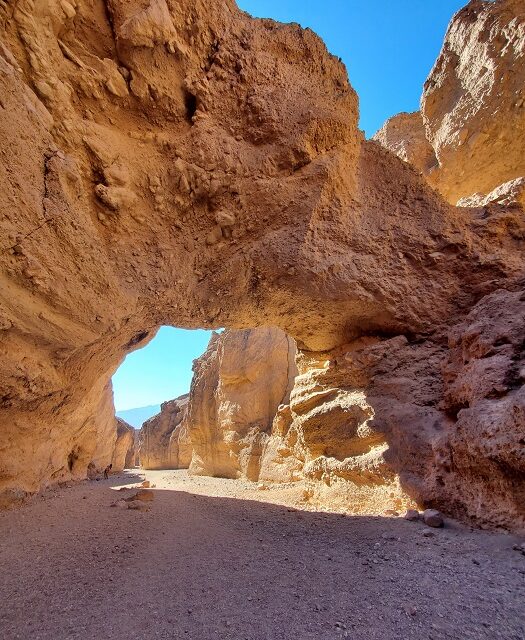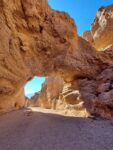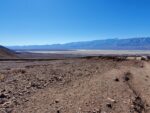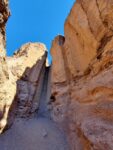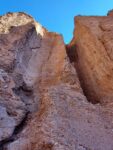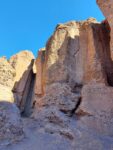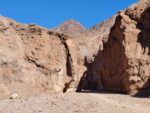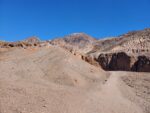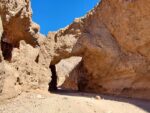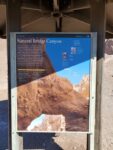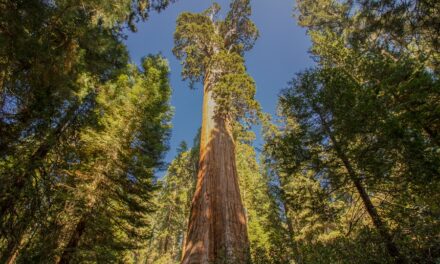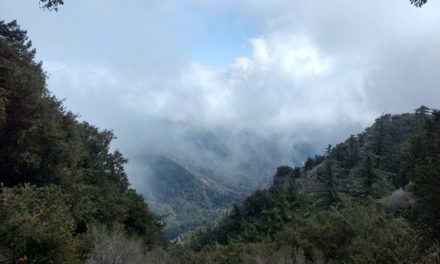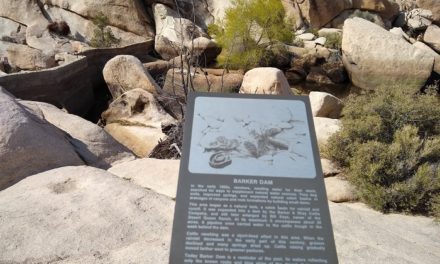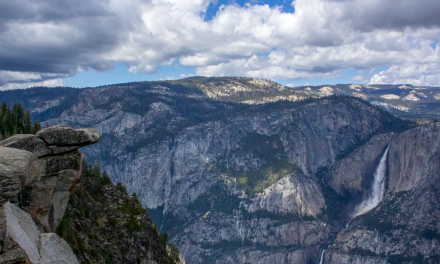Natural Bridge Canyon Hiking Guide – Death Valley National Park
The Natural Bridge trail is a short hike through a wash formed canyon in the Black Mountains of Death Valley National Park. Technically speaking, there is no official trail. The hike follows the natural bend of a wash through the canyon. The big highlight on this trail is for what the hike is named after, a natural bridge. The bridge stands thirty-five feet above the wash and measures the same in thickness connecting to each side of the canyon walls (1,2). Unlike the bridges and arches throughout Arches National Park that were created by wind, this bridge was formed by raging torrents of water.
Although Death Valley isn’t known for rain, flash floods do occur from time to time. When these violent and brief storms form, massive amounts of rain are unleashed in a short period. The soil is often so dry that it becomes hydrophobic and repels moisture. As the soil is unable to retain the water it gathers along the rocks and crevasses throughout the Black Mountains. The water is then funneled downward through canyons in the path of least resistance. It was over thousands of years and many flash floods later that the natural bridge was formed after water carved out a path through the rocky canyon. (1.2).
Aside from the natural bridge there are a few other highlights that this trail has to offer. The canyons throughout the mountains of Death Valley are generally barren and appear jagged with sheer vertical walls. The canyon that this hike takes place in is no different. Previous evidence of flooding will be visible throughout the hike with the appearance of dry falls throughout the canyon. The most notable of these will be a dry fall just a short distance past the bridge where the hike ends.
On A Personal Note
If you happen to be searching for this hike through the AllTrails app/website, the distance will be longer than what this hike actually is. The distance through AllTrails is 4.4 miles. The actual distance of the hike is just over one mile. The information through the AllTrails app is including the drive from Badwater Basin Road up to the parking lot to the trailhead.
Looking for other things to do nearby? The Black Mountains of Death Valley are full of different places to visit. For one of the most vibrant views in Death Valley, check out Zabrieskie Point. For a hike nearby, check out the Golden Canyon and Red Cathedral Trail.
Sources:
1. N.a. “Natural Bridge Canyon.” Death Valley National Park. National Park Service. U.S. Department Of The Interior. Exhibited at Natural Bridge Canyon Trail February 2021.
2. Gray, Jason. ” Natural Bridge.” Death Valley National Park. National Park Service. U.S. Department Of The Interior. https://www.nps.gov/places/natural-bridge.htm. Accessed 9 February 2022. Have an update to this trail location? Leave a comment below.
- Overall Difficulty: 35%
- Overall Views: 80%
Natural Bridge Trail Quick Facts:
- Max Elevation: 682 feet.
- Elevation Gain: 269 feet.
- Estimated Distance: 1.1 miles.
- My Actual Distance: 1.1 miles.
- Estimated Time: 30-90 minutes.
- My Time: 30 minutes moving; 36 minutes total.
Natural Bridge Trail Directions:
Natural Bridge Trail Pictures:
- The view of the natural bridge looking out of the wash.
- Looking down the base of the mountain towards Telescope Peak. The parking lot is on the right hand side.
- One of the dry falls where the trail terminates.
- Another dry fall.
- Another one of the dry falls.
- Looking into the beginning of the canyon.
- The start of the trail looking towards the base of the mountain.
- Looking directly at the arch.
- A placard at the trailhead.
Who The Natural Bridge Trail Is For:
Novice Hikers: This is a great trail with novice hikers or those not used to hiking longer distances. For such a short trail this hike does offer quite a few intriguing geological features.
Advanced Hikers: This is a pretty cool hike for such short distance. It’s not hard by any means. I recommend pairing this hike with several other shorter trails nearby.
Expert Hikers: This hike isn’t challenging or difficult. This is a great hike for a family day.
It’s always a good idea to be aware of what type of hiking level you’re at.
Best Time Of Year To Hike The Natural Bridge Trail:
Late fall to late winter is without a doubt the best time of year to hike this trail. The months near late fall or early spring can be tolerable but it is still rather warm. Once April-October comes around it is just hot. The middle of the summer is one of the hottest places on the entire planet and significant outdoor activity isn’t really recommended. Those who are sensitive to heat are advised to be out during the cooler hours of the morning or not at all.
One of the best things about visiting during the winter is seeing the view of Telescope Peak and the Panamint Range. These mountains are tall enough to catch residual weather systems coming off the Sierra Nevada. During the winter months the Panamint Range is often capped in snow and provides a nice contrast to the desert landscape. Once a decade or so enough rainfall will make its way into the valley to cause a rare superbloom with vibrant flowers.
Summer can bring about other problems besides just heat. The summer months is the monsoon season for the southwest desert. This season brings about the chance for lightning and thunderstorms. Avoid being out in the open during a thunderstorm to prevent being hit by lightning.It’s always a good idea to check the weather before heading out on a hike.
Natural Bridge Trail Conditions:
There isn’t an actual trail for this hike. The route follows the natural curve of the canyon until it ends at a dry waterfall. In the event of a flash flood it is possible for the trail to get washed out. However, this is a pretty rare event. Keep an eye out for rattlesnakes during the cooler hours or during the night.

